A New Image Processing Workflow for the Detection of Quartz Types in Shales: Implications for Shale Gas Reservoir Quality Prediction
Abstract
:1. Introduction
2. Geological Setting
3. Samples
4. Methods
4.1. Bulk Density, Optical and Scanning Electron Microscopy-Based Petrography
4.2. Shale Lithofacies Classification
4.3. Quartz Type Classification
4.4. Image Analysis
5. Results
5.1. Bulk Density
5.2. Optical Microscopy
- Spiral-like quartz (Figure 6c) is rarely observed. It has a columnar outline and is longer than the surrounding detrital minerals. When the microscope focus was slightly adjusted, an internal three-dimensional spiral-like microstructure could be observed, which can be used to differentiate it with sponge spicules.
- Siliceous sponge spicules often show up as needle-like, or with a massive debris attached (Figure 6d–f). In some cases, when observed with the crossed polarizers under microscopy and by rotating the object stage, the structure of the needle-like object embedded in the massive debris could be found (Figure 6e). However, in some cases, the embedded structure could not be found (Figure 6f).
- Polycrystalline quartz (Figure 6g) tends to exceed or approach the size of the largest detrital grains and shows up a variety of morphologies, such as elliptical and elongated. It was common in the N-6, but relatively rare in the other samples.
- Quartz veins are bedding-parallel and have a very high length to width ratio. They are of variable size (normally around several hundred micrometers, Figure 7a,b; unlike fault veins cutting through the sample), and contain vertically fibrous crystals [48]. Moreover quartz veins typically contain solid bitumen [8], either along their margins or within the veins.
5.3. Scanning Electron Microscopy
5.4. Quartz Types Based on Optical and Electron Microscopy
5.5. Shale Lithofacies
5.6. Image Analysis
- (i)
- 4–9 µm,
- (ii)
- 9–14 µm,
- (iii)
- 14–19 µm,
- (iv)
- 19–24 µm,
- (v)
- 24–29 µm,
- (vi)
- 35–39 µm, and
- (vii)
- 39–44 µm.
6. Discussion
6.1. Advantages and Disadvantages of This Workflow
6.2. Influence of Clay-Sized Quartz on Shale Gas Reservoir
6.3. Origin of Clay-Sized Quartz
7. Conclusions
- A workflow was proposed in this paper to calculate the content of clay-sized quartz in gas shales, by using a combination of microscopies, image analysis, and data of TOC content, bulk density, XRD.
- A refined shale lithofacies classification with seven major categories and nineteen subcategories was conducted. Based on it, three lithofacies of the Niutitang Fm shales were identified.
- A variety of quartz types in shale were observed and described in detail, including the detrital quartz, vein quartz, “elongated” quartz, needle-like quartz, and spiral-like quartz. Furthermore, the intergrowth of organic matter with oriented minerals was also considered as a type of quartz.
- The contents of various components, e.g., detrital quartz, clay-sized quartz and detrital feldspar, were semi-quantitatively calculated. Clay-sized quartz may be the main factor affecting mesopore volume and BET specific surface area. It is believed that clay-sized quartz accounts for most of the bulk quartz content in the Niutitang Fm shales and could origin from feldspar and quartz dissolution, clay transformation, and biogenic quartz transformation.
Author Contributions
Funding
Data Availability Statement
Acknowledgments
Conflicts of Interest
References
- Curtis, J.B. Fractured Shale-Gas Systems. AAPG Bull. 2002, 86, 1921–1938. [Google Scholar]
- EIA U.S. Natural Gas Gross Withdrawals from Shale Gas (Million Cubic Feet). Available online: https://www.eia.gov/dnav/ng/hist/ngm_epg0_fgs_nus_mmcfa.htm (accessed on 6 June 2022).
- Yu, H.; Liu, Q.; Yu, G. Analysis on the Strategic Target of Net Zero Carbon Emission of European Oil and Gas Companies in 2050. Int. Pet. Econ. 2020, 28, 31–36. [Google Scholar]
- Ma, Y.; Cai, X.; Zhao, P. China’s Shale Gas Exploration and Development: Understanding and Practice. Pet. Explor. Dev. 2018, 45, 561–574. [Google Scholar] [CrossRef]
- Zou, C.; Dong, D.; Yang, H.; Wang, Y.; Huang, J.; Wang, S.; Fu, C. Conditions of Shale Gas Accumulation and Exploration Practices in China. Nat. Gas Ind. 2011, 31, 26–39. [Google Scholar]
- Zou, C.; Dong, D.; Wang, S.; Li, J.; Li, X.; Wang, Y.; Li, D.; Cheng, K. Geological Characteristics and Resource Potential of Shale Gas in China. Pet. Explor. Dev. 2010, 37, 641–653. [Google Scholar]
- Misch, D.; Riedl, F.; Liu, B.; Horsfield, B.; Ziegs, V.; Mendez-Martin, F.; Vranjes-Wessely, S.; Sachsenhofer, R.F. Petrographic and Sorption-Based Characterization of Bituminous Organic Matter in the Mandal Formation, Central Graben (Norway). Int. J. Coal Geol. 2019, 211, 103229. [Google Scholar] [CrossRef]
- Misch, D.; Gross, D.; Hawranek, G.; Horsfield, B.; Klaver, J.; Mendez-Martin, F.; Urai, J.L.; Vranjes-Wessely, S.; Sachsenhofer, R.F.; Schmatz, J.; et al. Solid Bitumen in Shales: Petrographic Characteristics and Implications for Reservoir Characterization. Int. J. Coal Geol. 2019, 205, 14–31. [Google Scholar] [CrossRef]
- Misch, D.; Klaver, J.; Gross, D.; Mayer-Kiener, V.; Mendez-Martin, F.; Schmatz, J.; Sachsenhofer, R.F. Factors Controlling Shale Microstructure and Porosity: A Case Study on Upper Visean Rudov Beds from the Ukrainian Dneiper–Donets Basin. AAPG Bull. 2018, 102, 2629–2654. [Google Scholar] [CrossRef]
- Zhang, P.; Misch, D.; Meng, Q.; Bechtel, A.; Sachsenhofer, R.F.; Liu, Z.; Gao, F.; Hu, F.; Zhang, S.; Tang, B. Comprehensive Thermal Maturity Assessment in Shales: A Case Study on the Upper Cretaceous Qingshankou Formation (Songliao Basin, NE China). Int. J. Earth Sci. 2021, 110, 943–962. [Google Scholar] [CrossRef]
- Dowey, P.J.; Taylor, K.G. Diagenetic Mineral Development within the Upper Jurassic Haynesville-Bossier Shale, USA. Sedimentology 2020, 67, 47–77. [Google Scholar] [CrossRef]
- Cai, Q.; Hu, M.; Zhang, B.; Ngia, N.; Liu, A.; Liao, R.; Kane, O.; Li, H.; Hu, Z.; Deng, Q.; et al. Source of Silica and Its Implications for Organic Matter Enrichment in the Upper Ordovician-Lower Silurian Black Shale in Western Hubei Province, China: Insights from Geochemical and Petrological Analysis. Pet. Sci. 2022, 19, 74–90. [Google Scholar] [CrossRef]
- Loucks, R.G.; Reed, R.M.; Ruppel, S.C.; Hammes, U. Spectrum of Pore Types and Networks in Mudrocks and a Descriptive Classification for Matrix-Related Mudrock Pores. AAPG Bull. 2012, 96, 1071–1098. [Google Scholar] [CrossRef]
- Milliken, K.L.; McCarty, D.K.; Derkowski, A. Grain Assemblages and Diagenesis in the Tarl-Dominated Lower Silurian Mudrock Succession of the Western Margin of the East European Craton in Poland and Lithuania. Sediment. Geol. 2018, 374, 115–133. [Google Scholar] [CrossRef]
- Misch, D.; Wegerer, E.; Gross, D.; Sachsenhofer, R.F.; Rachetti, A.; Gratzer, R. Mineralogy and Facies Variations of Devonian and Carboniferous Shales in the Ukrainian Dniepr-Donets Basin. Austrian J. Earth Sci. 2018, 111, 15–25. [Google Scholar] [CrossRef]
- Chen, S.; Han, Y.; Fu, C.; Zhang, H.; Zhu, Y.; Zuo, Z. Micro and Nano-Size Pores of Clay Minerals in Shale Reservoirs: Implication for the Accumulation of Shale Gas. Sediment. Geol. 2016, 342, 180–190. [Google Scholar] [CrossRef]
- Raidla, V.; Kirsimäe, K.; Bityukova, L.; Jõeleht, A.; Shogenova, A.; Sliaupa, S. Lithology and Diagenesis of the Poorly Consolidated Cambrian Siliciclastic Sediments in the Northern Baltic Sedimentary Basin. Geol. Q. 2006, 50, 395–406. [Google Scholar]
- Wang, P.; Jiang, Z.; Yin, L.; Chen, L.; Li, Z.; Zhang, C.; Li, T.; Huang, P. Lithofacies Classification and Its Effect on Pore Structure of the Cambrian Marine Shale in the Upper Yangtze Platform, South China: Evidence from FE-SEM and Gas Adsorption Analysis. J. Pet. Sci. Eng. 2017, 156, 307–321. [Google Scholar] [CrossRef]
- Dong, C.; Ma, C.; Lin, C.; Sun, X.; Yuan, M. A method of classification of shale set. J. China Univ. Pet. Ed. Nat. Sci. 2015, 39, 1–7. [Google Scholar]
- Jiang, Y.; Song, Y.; Qi, L.; Chen, L.; Tao, Y.; Gan, H.; Wu, P.; Ye, Z. Fine Lithofacies of China’s Marine Shale and Its Logging Prediction: A Case Study of the Lower Silurian Longmaxi Marine Shale in Weiyuan Area, Southern Sichuan Basin, China. Earth Sci. Front. 2016, 23, 107–118. [Google Scholar]
- Jarvie, D.M.; Hill, R.J.; Ruble, T.E.; Pollastro, R.M. Unconventional Shale-Gas Systems: The Mississippian Barnett Shale of North-Central Texas as One Model for Thermogenic Shale-Gas Assessment. AAPG Bull. 2007, 91, 475–499. [Google Scholar] [CrossRef]
- Yao, J.; Sun, H.; Huang, C.; Zhang, L.; Zeng, Q.; Sui, H.; Fan, D. Key Mechanical Problems in the Developmentof Shale Gas Reservoirs. Sci. Sinca 2013, 43, 1527–1547. [Google Scholar]
- Misch, D.; Mendez-Martin, F.; Hawranek, G.; Onuk, P.; Gross, D.; Sachsenhofer, R.F. SEM and FIB-SEM Investigations on Potential Gas Shales in the Dniepr-Donets Basin (Ukraine): Pore Space Evolution in Organic Matter during Thermal Maturation. IOP Conf. Ser. Mater. Sci. Eng. 2016, 109, 012010. [Google Scholar] [CrossRef]
- Dong, T.; He, S.; Chen, M.; Hou, Y.; Guo, X.; Wei, C.; Han, Y.; Yang, R. Quartz Types and Origins in the Paleozoic Wufeng-Longmaxi Formations, Eastern Sichuan Basin, China: Implications for Porosity Preservation in Shale Reservoirs. Mar. Pet. Geol. 2019, 106, 62–73. [Google Scholar] [CrossRef]
- Milliken, K.L. SEM-Based Cathodoluminescence Imaging for Discriminating Quartz Types in Mudrocks. In Proceedings of the Unconventional Resources Technology Conference, Society of Exploration Geophysicists, American Association of Petroleum Geologists, Denver, CO, USA, 14 August 2013; Society of Petroleum Engineers: Richardson, TX, USA, 2013; pp. 2286–2294. [Google Scholar]
- Guo, X.; Hu, D.; Huang, R.; Wei, Z.; Duan, J.; Wei, X.; Fan, X.; Miu, Z. Deep and Ultra-Deep Natural Gas Exploration in the Sichuan Basin: Progress and Prospect. Nat. Gas Ind. 2020, 40, 419–432. [Google Scholar] [CrossRef]
- Hu, Z.; Du, W.; Peng, Y.; Zhao, J. Shale Micro-Pore Characteristics and Source-Reservoir Relationship: Taking Wufeng Formation-Longmaxi Formation in Southeast Sichuan as an Example. Oil Gas Geol. 2015, 36, 1001–1008. [Google Scholar]
- Milliken, K.L.; Ergene, S.M.; Ozkan, A. Quartz Types, Authigenic and Detrital, in the Upper Cretaceous Eagle Ford Formation, South Texas, USA. Sediment. Geol. 2016, 339, 273–288. [Google Scholar] [CrossRef]
- Xu, H.; Zhou, W.; Hu, Q.; Yi, T.; Ke, J.; Zhao, A.; Lei, Z.; Yu, Y. Quartz Types, Silica Sources and Their Implications for Porosity Evolution and Rock Mechanics in the Paleozoic Longmaxi Formation Shale, Sichuan Basin. Mar. Pet. Geol. 2021, 128, 105036. [Google Scholar] [CrossRef]
- Liu, Y.; Wang, K.; Hu, P.; Li, W. A Discussion on Measuring Methods of Shale Mineral Components. Nat. Gas Geosci. 2015, 26, 1737–1743. [Google Scholar]
- Guo, S.; Misch, D.; Zhu, Y. A Semi-Quantitative Method to Quantify Clay-Sized Quartz in Gas Shale; European Association of Geoscientists & Engineers: Bunnik, The Netherlands, 2022; Volume 2022, pp. 1–5. [Google Scholar]
- Li, Z.; Bogdanova, S.V.; Collins, A.S.; Davidson, A.; De Waele, B.; Ernst, R.E.; Fitzsimons, I.C.W.; Fuck, R.A.; Gladkochub, D.P.; Jacobs, J.; et al. Assembly, Configuration, and Break-up History of Rodinia: A Synthesis. Precambrian Res. 2008, 160, 179–210. [Google Scholar] [CrossRef]
- Meert, J.G.; Van Der Voo, R. The Assembly of Gondwana 800–550 Ma. J. Geodyn. 1997, 23, 223–235. [Google Scholar] [CrossRef]
- Hoffman, P.F.; Kaufman, A.J.; Halverson, G.P.; Schrag, D.P. A Neoproterozoic Snowball Earth. Science 1998, 281, 1342–1346. [Google Scholar] [CrossRef] [PubMed]
- Vail, P.R.; Mitchum, R.M.; Thompson, S. Seismic Stratigraphy and Global Changes of Sea Level, Part 4: Global Cycles of Relative Changes of Sea Level. In Seismic Stratigraphy-Applications to Hydrocarbon Exploration; American Association of Petroleum Geologists: Tulsa, OK, USA, 1977; pp. 63–81. [Google Scholar]
- Woodcock, N.H. The Cambrian and Earliest Ordovician Quiescent Margin of Gondwana. In Geological History of Britain and Ireland; Woodcock, N.H., Strachan, R.A., Eds.; John Wiley and Sons: New York, NY, USA, 2012; pp. 150–161. [Google Scholar]
- Mángano, M.G.; Buatois, L.A. The Cambrian Explosion. In The Trace-Fossil Record of Major Evolutionary Events: Volume 1: Precambrian and Paleozoic; Mángano, M.G., Buatois, L.A., Eds.; Topics in Geobiology; Springer Netherlands: Dordrecht, The Netherlands, 2016; pp. 73–126. [Google Scholar]
- Shu, D. Cambrian Explosion: Birth of Tree of Animals. Gondwana Res. 2008, 14, 219–240. [Google Scholar] [CrossRef]
- Torsvik, T.H.; Cocks, L.R.M. Cambrian. In Earth History and Palaeogeography; Cambridge University Press: Cambridge, UK, 2016; pp. 85–100. [Google Scholar]
- Huang, B.; Zhu, R.; Otofuji, Y.; Yang, Z. The Early Paleozoic Paleogeography of the North China Block and the Other Major Blocks of China. Chin. Sci. Bull. 2000, 45, 1057–1065. [Google Scholar] [CrossRef]
- Guan, S.; Zhang, C.; Ren, R.; Zhang, S.; Wu, L.; Wang, L.; Ma, P.; Han, C. Early Cambrian Syndepositional Structure of the Northern Tarim Basin and a Discussion of Cambrian Subsalt and Deep Exploration. Pet. Explor. Dev. 2019, 46, 1141–1152. [Google Scholar] [CrossRef]
- Shi, C.; Cao, J.; Han, S.; Hu, K.; Bian, L.; Yao, S. A Review of Polymetallic Mineralization in Lower Cambrian Black Shales in South China: Combined Effects of Seawater, Hydrothermal Fluids, and Biological Activity. Palaeogeogr. Palaeoclimatol. Palaeoecol. 2021, 561, 110073. [Google Scholar] [CrossRef]
- Zhang, S.; Gao, Z.; Li, J.; Zhang, B.; Gu, Q.; Lu, Y. Identification and Distribution of Marine Hydrocarbon Source Rocks in the Ordovician and Cambrian of the Tarim Basin. Pet. Explor. Dev. 2012, 39, 305–314. [Google Scholar] [CrossRef]
- Zhu, G.; Chen, F.; Wang, M.; Zhang, Z.; Ren, R.; Wu, L. Discovery of the Lower Cambrian High-Quality Source Rocks and Deep Oil and Gas Exploration Potential in the Tarim Basin, China. AAPG Bull. 2018, 102, 2123–2151. [Google Scholar] [CrossRef]
- Wu, K.; Zhang, T.; Yang, Y.; Sun, Y.; Yuan, D. Contribution of Oxygenic Photosynthesis to Palaeo-Oceanic Organic Carbon Sink Fluxes in Early Cambrian Upper Yangtze Shallow Sea: Evidence from Black Shale Record. J. Earth Sci. 2016, 27, 211–224. [Google Scholar] [CrossRef]
- Han, S.; Wang, S. An Approach on Stages of Oil Generation and Evolution of Lower Paleozoic in the Eastern part of South Guizhou. Exp. Pet. Geol. 1983, 5, 1–8. [Google Scholar]
- Chen, F.; Ding, X.; Lu, S.; He, X.; Xing, H. Gas Generation Characteristics of the Lower Cambrian Niutitang Shale in Qiannan Depression, China. Pet. Sci. Technol. 2017, 35, 1209–1216. [Google Scholar] [CrossRef]
- Guo, S.; Zhu, Y.; Liu, Y.; Tang, X. Characteristics and Controlling Factors of Nanopores of the Niutitang Formation Shale from Jiumen Outcrop, Guizhou Province. J. Nanosci. Nanotechnol. 2021, 21, 284–295. [Google Scholar] [CrossRef] [PubMed]
- Luo, C.; Liu, S.; Sun, W.; Ran, B.; Yong, Z.; Yang, D.; Zhang, X.; Wang, S.; Ye, Y.; Deng, B. Basic Characteristics of Shale Gas in the Lower Cambrian Niutitang Formation in the Upper Yangtze Region: Taking Nangao Section in Danzhai as an Example. Nat. Gas Geosci. 2014, 25, 453–470. [Google Scholar]
- Tian, H.; Pan, L.; Zhang, T.; Xiao, X.; Meng, Z.; Huang, B. Pore Characterization of Organic-Rich Lower Cambrian Shales in Qiannan Depression of Guizhou Province, Southwestern China. Mar. Pet. Geol. 2015, 62, 28–43. [Google Scholar] [CrossRef]
- Liu, Z.; Zhuang, X.; Teng, G.E.; Xie, X.; Yin, L.; Bian, L.; Feng, Q.; Algeo, T. The Lower Cambrian Niutitang Formation at Yangtiao (Guizhou, SW China): Organic Matter Enrichment, Source Rock Potential, and Hydrothermal Influences. J. Pet. Geol. 2015, 38, 411–432. [Google Scholar] [CrossRef]
- Klaver, J.; Desbois, G.; Urai, J.L.; Littke, R. BIB-SEM Study of the Pore Space Morphology in Early Mature Posidonia Shale from the Hils Area, Germany. Int. J. Coal Geol. 2012, 103, 12–25. [Google Scholar] [CrossRef]
- Wang, Y.; Wang, S.; Dong, D.; Li, X.; Huang, J.; Zhang, C.; Guan, Q. Lithofacies Characterization of Longmaxi Formation of the Lower Silurian, Southern Sichuan. Earth Sci. Front. 2016, 23, 119–223. [Google Scholar]
- Lu, L.; Xu, W. Endogenetic Sedimentary Rock. In Petrology; Li, K., Ed.; Geological Publishing House: Beijing, China, 2011; pp. 204–216. [Google Scholar]
- Loucks, R.G.; Reed, R.M.; Ruppel, S.C.; Jarvie, D.M. Morphology, Genesis, and Distribution of Nanometer-Scale Pores in Siliceous Mudstones of the Mississippian Barnett Shale. J. Sediment. Res. 2009, 79, 848–861. [Google Scholar] [CrossRef]
- Peng, J.; Milliken, K.L.; Fu, Q. Quartz Types in the Upper Pennsylvanian Organic-Rich Cline Shale (Wolfcamp D), Midland Basin, Texas: Implications for Silica Diagenesis, Porosity Evolution and Rock Mechanical Properties. Sedimentology 2020, 67, 2040–2064. [Google Scholar] [CrossRef]
- Yue, L.; Kang, Y.; Chen, Q.; Shang, Y.; She, Z.; Chen, L. Analysis of Shale Gas Potential of Niutitang Formation of Lower Cambrian in Guizhou, China. Xinjiang Pet. Geol. 2013, 34, 123–128. [Google Scholar]
- Williams, L.A.; Crerar, D.A. Silica Diagenesis; II, General Mechanisms. J. Sediment. Res. 1985, 55, 312–321. [Google Scholar]
- de Melo, M.S.; Guimarães, G.B.; Chinelatto, A.L.; Giannini, P.C.F.; Pontes, H.S.; Chinelatto, A.S.A.; Atencio, D. Kaolinite, Illite and Quartz Dissolution in the Karstification of Paleozoic Sandstones of the Furnas Formation, Paraná Basin, Southern Brazil. J. South Am. Earth Sci. 2015, 63, 20–35. [Google Scholar] [CrossRef]
- Harris, N.B. Burial Diagenesis of Brent Sandstones: A Study of Statfjord, Hutton and Lyell Fields. Geol. Soc. Lond. Spec. Publ. 1992, 61, 351–375. [Google Scholar] [CrossRef]
- Bloch, J.; Hutcheon, I.E. Shale Diagenesis: A Case Study from the Albian Harmon Member (Peace River Formation), Western Canada. Clays Clay Miner. 1992, 40, 682–699. [Google Scholar] [CrossRef]
- Milliken, K.L.; Choh, S.J.; Papazis, P.; Schieber, J. “Cherty” Stringers in the Barnett Shale Are Agglutinated Foraminifera. Sediment. Geol. 2007, 198, 221–232. [Google Scholar] [CrossRef]
- van de Kamp, P.C. Smectite-Illite-Muscovite Transformations, Quartz Dissolution, and Silica Release in Shales. Clays Clay Miner. 2008, 56, 66–81. [Google Scholar] [CrossRef]
- Zhao, J.; Jin, Z.; Jin, Z.; Wen, X.; Geng, Y.; Yan, C. The Genesis of Quartz in Wufeng-Longmaxi Gas Shales, Sichuan Basin. Nat. Gas Geosci. 2016, 27, 377–386. [Google Scholar]
- Loucks, R.G.; Ruppel, S.C. Mississippian Barnett Shale: Lithofacies and Depositional Setting of a Deep-Water Shale-Gas Succession in the Fort Worth Basin, Texas. AAPG Bull. 2007, 91, 579–601. [Google Scholar] [CrossRef]
- Zhang, K.; Feng, Q. Early Cambrian Radiolarians and Sponge Spicules from the Niujiaohe Formation in South China. Palaeoworld 2019, 28, 234–242. [Google Scholar] [CrossRef]
- Hendry, J.P.; Trewin, N.H. Authigenic Quartz Microfabrics in Cretaceous Turbidites; Evidence for Silica Transformation Processes in Sandstones. J. Sediment. Res. 1995, 65, 380–392. [Google Scholar]
- Köhn, D. Kinematics of Fibrous Aggregates. Ph.D. Thesis, Johannes Gutenberg-Universität Mainz, Mainz, Germany, 2000. [Google Scholar]
- Schieber, J.; Krinsley, D.; Riciputi, L. Diagenetic Origin of Quartz Silt in Mudstones and Implications for Silica Cycling. Nature 2000, 406, 981–985. [Google Scholar] [CrossRef]
- Li, S.; Xu, H.; Shen, J.; Li, G. Oxide and Hydroxide Minerals Main Category. In Crystallography and Mineralogy; Wang, P., Chen, L., Eds.; Geological Publishing House: Beijing, China, 2008; pp. 180–201. [Google Scholar]
- Chen, J.; Shao, Z.; Qin, Y. Sedimentary Organic Matter Composition. In Energy Geology; Song, D., Ed.; China University of Mining and Technology Press: Xuzhou, China, 2004; pp. 31–85. [Google Scholar]
- Tribovillard, N.; Algeo, T.J.; Lyons, T.; Riboulleau, A. Trace Metals as Paleoredox and Paleoproductivity Proxies: An Update. Chem. Geol. 2006, 21, 12–32. [Google Scholar] [CrossRef]
- Nie, H.; He, Z.; Liu, G.; Du, W.; Wang, R.; Zhang, G. Genetic Mechanism of High-Quality Shale Gas Reservoirs in the Wufeng–LongmaxiFms in the Sichuan Basin. Nat. Gas Ind. B 2021, 8, 24–34. [Google Scholar] [CrossRef]
- Knapp, L.J.; Ardakani, O.H.; Uchida, S.; Nanjo, T.; Otomo, C.; Hattori, T. The Influence of Rigid Matrix Minerals on Organic Porosity and Pore Size in Shale Reservoirs: Upper Devonian Duvernay Formation, Alberta, Canada. Int. J. Coal Geol. 2020, 227, 103525. [Google Scholar] [CrossRef]
- Wu, L.; Lu, Y.; Jiang, S.; Lu, Y.; Liu, X.; Hu, H. Pore Structure Characterization of Different Lithofacies in Marine Shale: A Case Study of the Upper Ordovician Wufeng-Lower Silurian Longmaxi Formation in the Sichuan Basin, SW China. J. Nat. Gas Sci. Eng. 2018, 57, 203–215. [Google Scholar] [CrossRef]
- Rybacki, E.; Reinicke, A.; Meier, T.; Makasi, M.; Dresen, G. What Controls the Mechanical Properties of Shale Rocks—Part I: Strength and Young’s Modulus. J. Pet. Sci. Eng. 2015, 135, 702–722. [Google Scholar] [CrossRef]
- Chen, S.; Qin, Y.; Wang, Y.; Zhang, H.; Zuo, Z. Pore Structure and Heterogeneity of Marine Shales in the Middle-Upper Yangtze. Nat. Gas Geosci. 2015, 26, 1455–1463. [Google Scholar]
- Metwally, Y.M.; Chesnokov, E.M. Clay Mineral Transformation as a Major Source for Authigenic Quartz in Thermo-Mature Gas Shale. Appl. Clay Sci. 2012, 55, 138–150. [Google Scholar] [CrossRef]
- Zhu, H.; Ju, Y.; Yang, M.; Huang, C.; Feng, H.; Qiao, P.; Ma, C.; Su, X.; Lu, Y.; Shi, E.; et al. Grain-Scale Petrographic Evidence for Distinguishing Detrital and Authigenic Quartz in Shale: How Much of a Role Do They Play for Reservoir Property and Mechanical Characteristic? Energy 2022, 239, 122176. [Google Scholar] [CrossRef]
- Liu, J.; Ding, W.; Wang, R.; Wu, Z.; Gong, D.; Wang, X.; Yin, S.; Jiao, B. Quartz Types in Shale and Their Effect on Geomechanical Properties: An Example from the Lower Cambrian Niutitang Formation in the Cen’gong Block, South China. Appl. Clay Sci. 2018, 163, 100–107. [Google Scholar] [CrossRef]
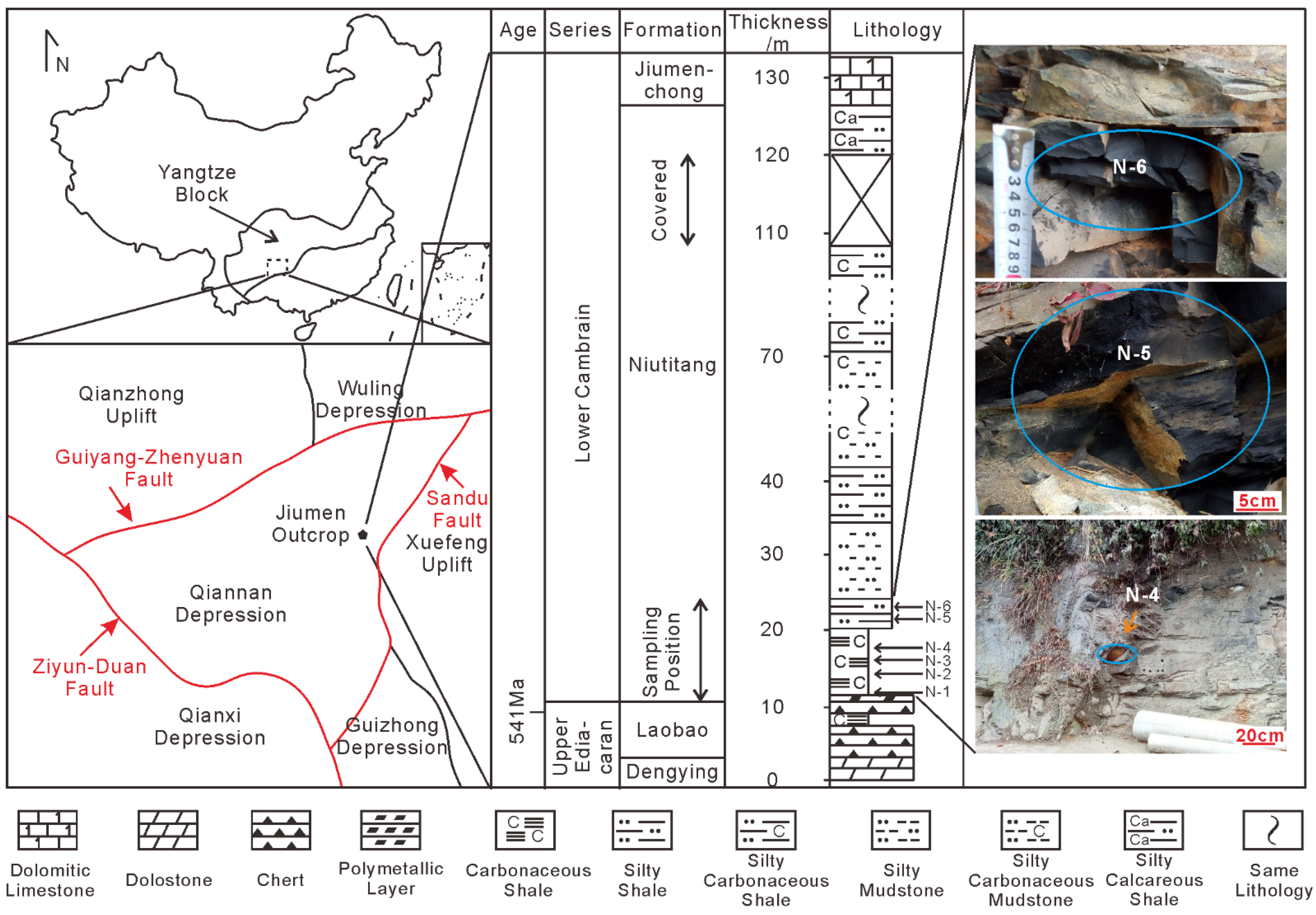
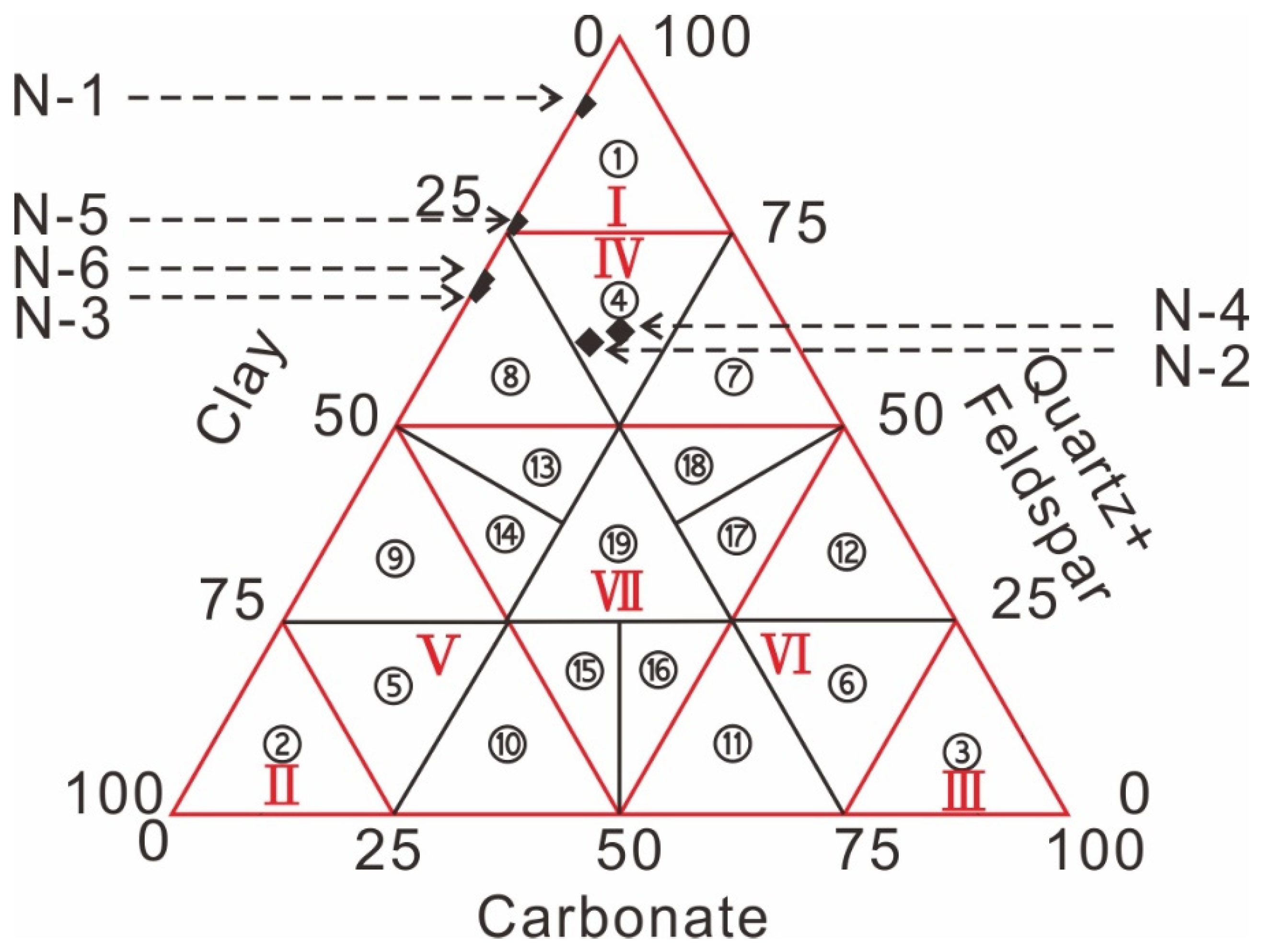



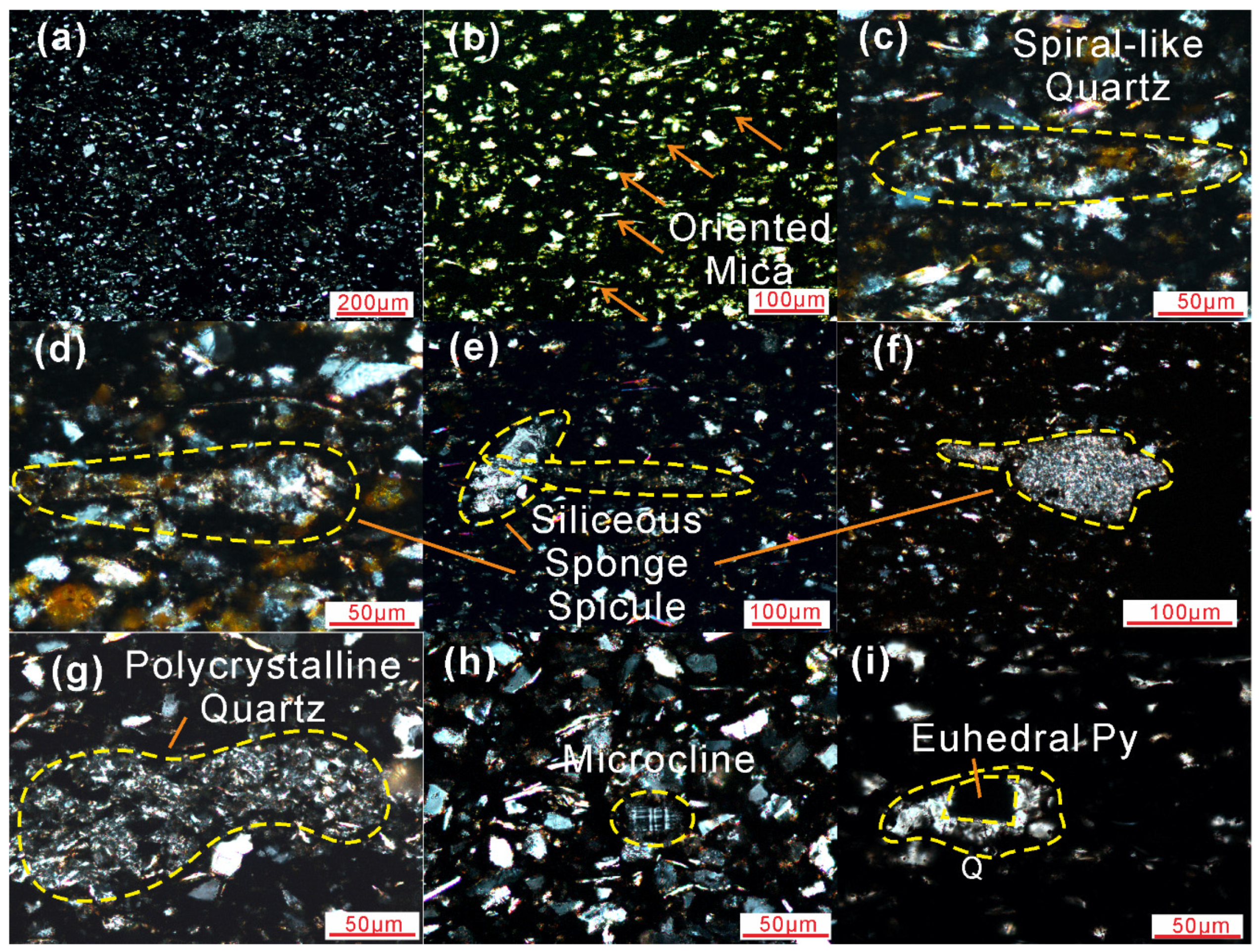
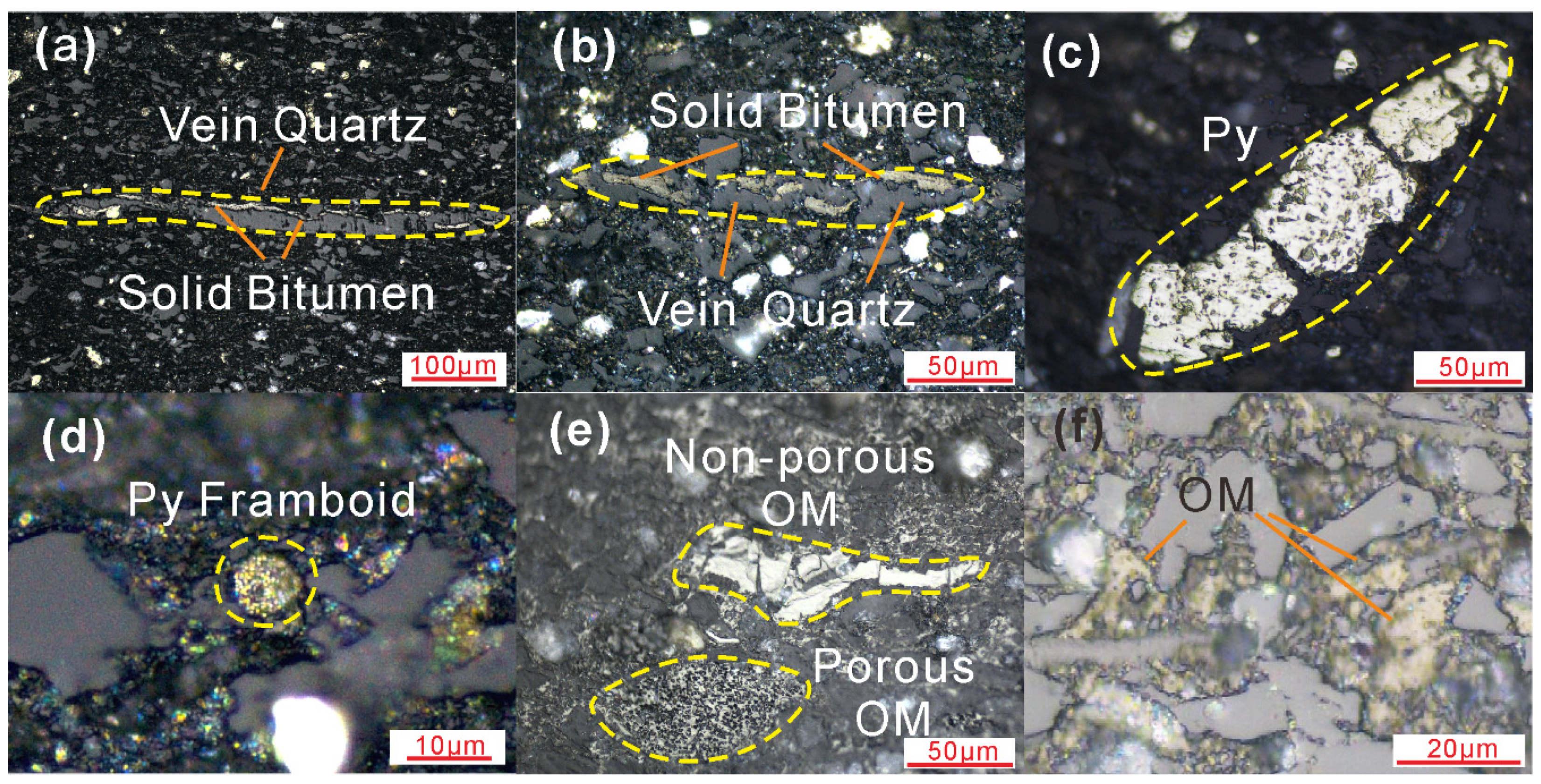

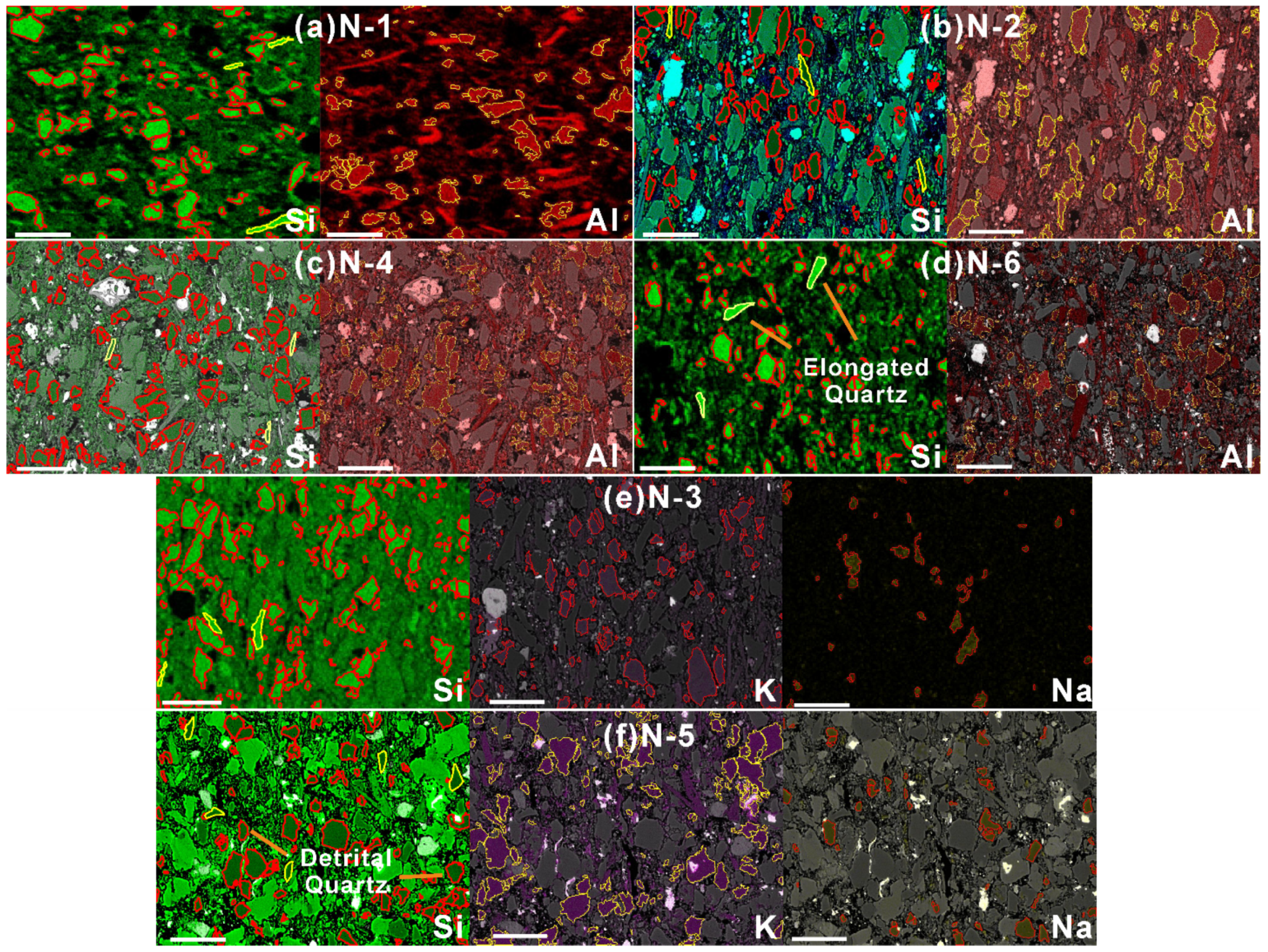
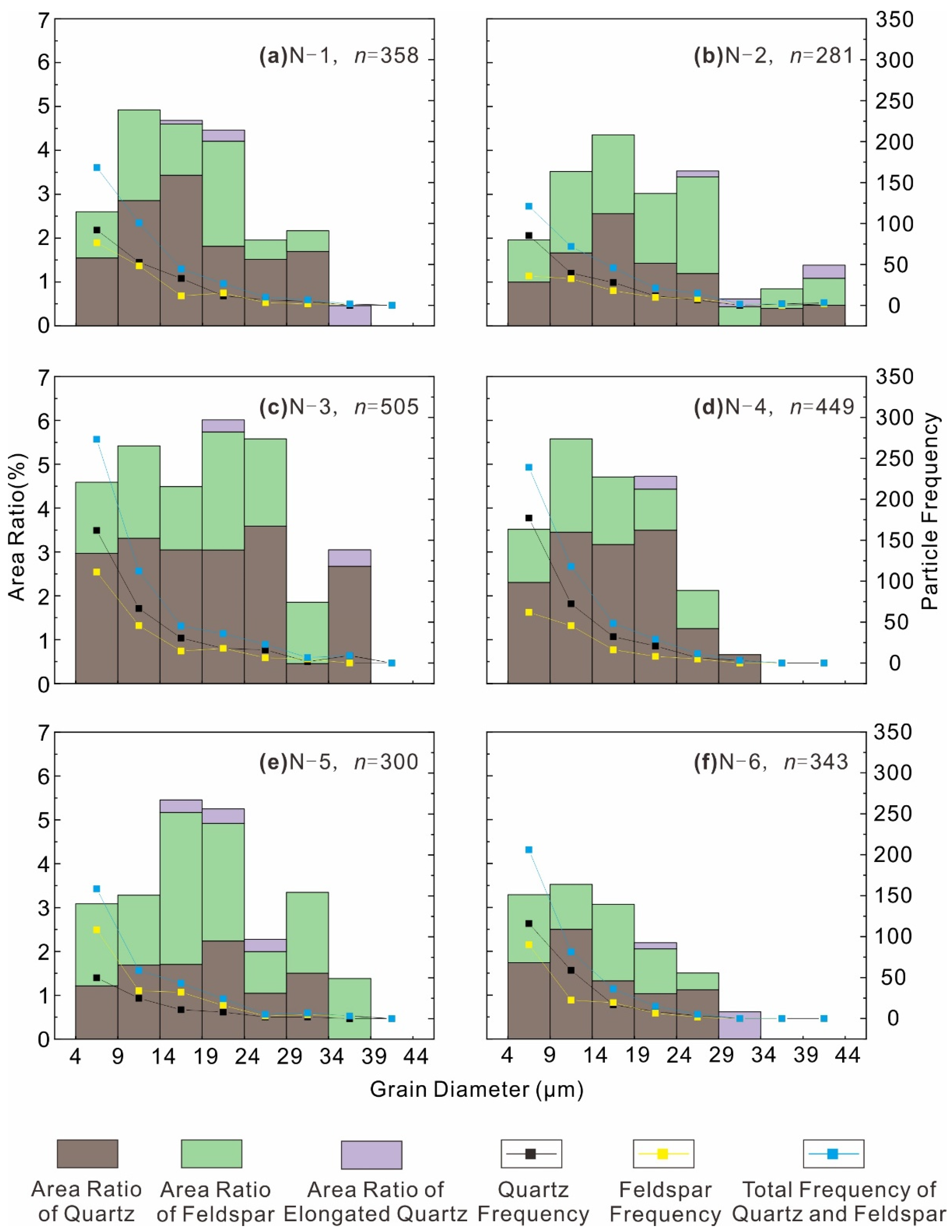


| Sample | Bulk Mineralogical Composition (wt.%). 1 | TOC (%). 1 | Bulk Density (g/cm3) | ||||||||
|---|---|---|---|---|---|---|---|---|---|---|---|
| Q | K-Feldspar | Plagioclase | Dolomite | Pyroxene | Illite | Kaolinite | Pyrite | Barite | |||
| N-1 | 71.1 | 10 | 4.1 | 8 | 6.8 | 10.0 | 2.24 | ||||
| N-2 | 44.4 | 6.3 | 13.5 | 11.2 | 8.1 | 10.8 | 5.7 | 12.7 2 | 2.33 | ||
| N-3 | 47.7 | 5.6 | 4.3 | 8.5 | 27.5 | 6.4 | 4.8 | 2.46 | |||
| N-4 | 46.2 | 6.5 | 2.8 | 16.9 | 7.3 | 17 | 3.3 | 9.9 | 2.19 | ||
| N-5 | 60.2 | 7.9 | 6.8 | 21.2 | 3.9 | 10.0 | 2.30 | ||||
| N-6 | 50.6 | 4 | 3.7 | 27 | 10.4 | 4.3 | 8.8 | 2.34 | |||
| AR, (%) | N-1 | N-2 | N-3 | N-4 | N-5 | N-6 | |||||||||||||
|---|---|---|---|---|---|---|---|---|---|---|---|---|---|---|---|---|---|---|---|
| dQ | dF | dQ + F | dQ | dF | dQ + F | dQ | dF | dQ + F | dQ | dF | dQ + F | dQ | dF | dQ + F | dQ | dF | dQ + F | ||
| Particle Size Interval, (μm) | (4–9) | 1.6 | 1.1 | 2.6 | 1 | 1 | 2 | 3 | 1.6 | 4.6 | 2.3 | 1.2 | 3.5 | 1.2 | 1.9 | 3.1 | 1.7 | 1.6 | 3.3 |
| (9–14) | 2.9 | 2.1 | 4.9 | 1.7 | 1.9 | 3.5 | 3.3 | 2.1 | 5.4 | 3.5 | 2.1 | 5.6 | 1.7 | 1.6 | 3.3 | 2.5 | 1.0 | 3.5 | |
| (14–19) | 3.4 | 1.2 | 4.6 | 2.6 | 1.8 | 4.4 | 3.1 | 1.4 | 4.5 | 3.2 | 1.5 | 4.7 | 1.7 | 3.5 | 5.2 | 1.3 | 1.7 | 3.1 | |
| (19–24) | 1.8 | 2.4 | 4.2 | 1.4 | 1.6 | 3 | 3.1 | 2.7 | 5.7 | 3.5 | 0.9 | 4.4 | 2.2 | 2.7 | 4.9 | 1 | 1 | 2.1 | |
| (24–29) | 1.5 | 0.4 | 2 | 1.2 | 2.2 | 3.4 | 3.6 | 2.0 | 5.6 | 1.3 | 0.9 | 2.1 | 1.1 | 1 | 2 | 1.1 | 0.4 | 1.5 | |
| (29–34) | 1.7 | 0.5 | 2.2 | 0 | 0.4 | 0.4 | 0.5 | 1.4 | 1.9 | 0.7 | 0 | 0.7 | 1.5 | 1.8 | 3.4 | 0 | 0 | 0 | |
| (34–39) | 0 | 0 | 0 | 0.4 | 0.5 | 0.9 | 2.7 | 0 | 2.7 | 0 | 0 | 0 | 0 | 1.4 | 1.4 | 0 | 0 | 0 | |
| (39–44) | 0 | 0 | 0 | 0.5 | 0.6 | 1.1 | 0 | 0 | 0 | 0 | 0 | 0 | 0 | 0 | 0 | 0 | 0 | 0 | |
| dQ/dF/dQ + F | 12.8 | 7.6 | 20.5 | 8.7 | 9.9 | 18.6 | 19.1 | 5.3 | 24.3 | 14.3 | 6.7 | 21 | 9.4 | 9.6 | 19 | 7.7 | 5.7 | 13.4 | |
| (9–24)dQ | 8.1 | 5.7 | 9.4 | 10.1 | 5.6 | 4.9 | |||||||||||||
| (9–24)dQ–dQ | 63 | 65 | 49 | 71 | 60 | 62.9 | |||||||||||||
| (9–24)dQ + F | 13.7 | 10.9 | 15.6 | 14.7 | 13.4 | 8.7 | |||||||||||||
| (9–24)dQ + F-dQ + F | 67.1 | 58.5 | 51.6 | 70 | 57.7 | 64.3 | |||||||||||||
| Average dQ + F Size, (μm) | 11.1 | 12 | 11 | 10.2 | 11 | 9.4 | |||||||||||||
| Standard deviation of dQ + F Size | 6.5 | 7.1 | 7.1 | 5.7 | 6.7 | 4.9 | |||||||||||||
| RdQ-dF | 1.7 | 0.9 | 3.6 | 2.1 | 0.98 | 1.4 | |||||||||||||
| Sample | N-1 | N-2 | N-3 | N-4 | N-5 | N-6 | |
|---|---|---|---|---|---|---|---|
| Particle Size Interval, (μm) | (4, 9) | ||||||
| (9, 14) | |||||||
| (14, 19) | 0.08 | 0.29 | |||||
| (19, 24) | 0.25 | 0.28 | 0.29 | 0.33 | 0.14 | ||
| (24, 29) | 0.14 | 0.28 | |||||
| (29, 34) | 0.18 | 0.62 | |||||
| (34, 39) | 0.46 | 0.38 | |||||
| (39, 44) | 0.3 | ||||||
| Sample | Weight of Mineral Matter in 1 cm3 (g) | ||||||||
|---|---|---|---|---|---|---|---|---|---|
| Quartz | K-Feldspar | Plagioclase | Feldspar | Dolomite | Pyroxene | Clay Mineral | Pyrite | Barite | |
| N-1 | 1.42 | 0.2 | 0.08 | 0.28 | 0 | 0 | 0.16 | 0 | 0.14 |
| N-2 | 0.89 | 0.13 | 0 | 0.13 | 0.27 | 0 | 0.39 | 0.22 | 0.11 |
| N-3 | 1.11 | 0.13 | 0.1 | 0.23 | 0 | 0.20 | 0.64 | 0.15 | 0 |
| N-4 | 0.9 | 0.13 | 0.05 | 0.18 | 0.33 | 0.14 | 0.33 | 0 | 0.06 |
| N-5 | 1.23 | 0.16 | 0 | 0.16 | 0 | 0.14 | 0.43 | 0 | 0.08 |
| N-6 | 1.07 | 0.08 | 0.08 | 0.16 | 0 | 0 | 0.57 | 0.22 | 0.09 |
| Parameter | N-1 | N-2 | N-3 | N-4 | N-5 | N-6 |
|---|---|---|---|---|---|---|
| ρQ, ρF (g/cm3) | 2.65 | |||||
| TOC (%) | 10 | 12.7 | 4.8 | 9.9 | 10 | 8.8 |
| WOM (g/cm3) | 0.25 | 0.33 | 0.13 | 0.24 | 0.26 | 0.23 |
| WMM (g/cm3) | 2 | 2 | 2.3 | 2 | 2 | 2.1 |
| VRdQ (%) | 12.9 | 8.7 | 19.1 | 14.3 | 9.4 | 7.7 |
| WdQ (g/cm3) | 0.34 | 0.23 | 0.51 | 0.38 | 0.25 | 0.2 |
| WRdQ-MM (%) | 17.1 | 11.6 | 21.7 | 19.5 | 12.2 | 9.7 |
| WRdQ-S (%) | 15.2 | 9.9 | 20.6 | 17.4 | 10.8 | 8.7 |
| ρS (g/cm3) | 2.24 | 2.33 | 2.46 | 2.19 | 2.3 | 2.34 |
| WRtQ-MM (%) | 71.1 | 44.4 | 47.7 | 46.2 | 60.2 | 50.6 |
| WcQ (g/cm3) | 1.05 | 0.64 | 0.59 | 0.51 | 0.96 | 0.84 |
| WRcQ-tQ (%) | 74 | 72 | 53 | 57 | 78 | 79 |
| WRcQ-S (%) | 47 | 28 | 24 | 23 | 42 | 36 |
| WRcQ-MM (%) | 53 | 32 | 25 | 26 | 47 | 40 |
| VReQ (%) | 0.8 | 0.61 | 0.65 | 0.29 | 0.9 | 0.76 |
| WeQ (g/cm3) | 0.021 | 0.016 | 0.017 | 0.008 | 0.024 | 0.02 |
| WReQ-tQ (%) | 1.5 | 1.8 | 1.6 | 0.9 | 1.9 | 1.9 |
| WReQ-S (%) | 0.94 | 0.69 | 0.7 | 0.35 | 1.03 | 0.86 |
| WReQ-MM (%) | 1.06 | 0.81 | 0.74 | 0.4 | 1.16 | 0.96 |
| VRP (%) | - | - | 6 | 4.3 | 4.2 | - |
Publisher’s Note: MDPI stays neutral with regard to jurisdictional claims in published maps and institutional affiliations. |
© 2022 by the authors. Licensee MDPI, Basel, Switzerland. This article is an open access article distributed under the terms and conditions of the Creative Commons Attribution (CC BY) license (https://creativecommons.org/licenses/by/4.0/).
Share and Cite
Guo, S.; Misch, D.; Sachsenhofer, R.F.; Zhu, Y.; Tang, X.; Bai, W. A New Image Processing Workflow for the Detection of Quartz Types in Shales: Implications for Shale Gas Reservoir Quality Prediction. Minerals 2022, 12, 1027. https://doi.org/10.3390/min12081027
Guo S, Misch D, Sachsenhofer RF, Zhu Y, Tang X, Bai W. A New Image Processing Workflow for the Detection of Quartz Types in Shales: Implications for Shale Gas Reservoir Quality Prediction. Minerals. 2022; 12(8):1027. https://doi.org/10.3390/min12081027
Chicago/Turabian StyleGuo, Sen, David Misch, Reinhard F. Sachsenhofer, Yanming Zhu, Xin Tang, and Weichen Bai. 2022. "A New Image Processing Workflow for the Detection of Quartz Types in Shales: Implications for Shale Gas Reservoir Quality Prediction" Minerals 12, no. 8: 1027. https://doi.org/10.3390/min12081027
APA StyleGuo, S., Misch, D., Sachsenhofer, R. F., Zhu, Y., Tang, X., & Bai, W. (2022). A New Image Processing Workflow for the Detection of Quartz Types in Shales: Implications for Shale Gas Reservoir Quality Prediction. Minerals, 12(8), 1027. https://doi.org/10.3390/min12081027





